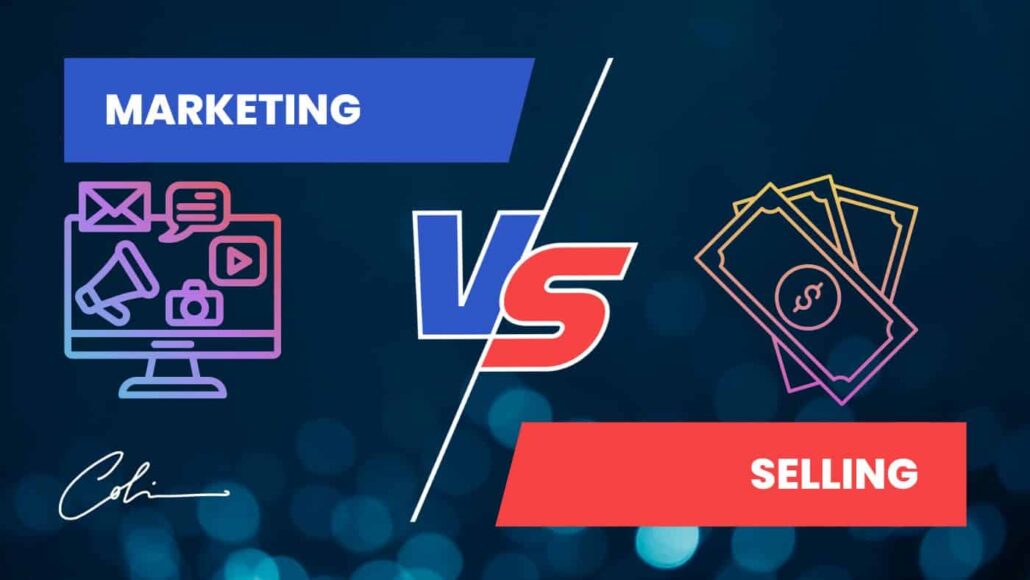We need the right combination of selling and marketing to promote our goods and services. Any successful business relies on a certain level of each if it's going to ensure its profitability.
Many people mistake them for two of the same thing, however, the fundamental differences between selling and marketing are important to understand since the lines are pretty blurred.

The key difference between them is that marketing is all about attracting buyers and creating a preference for your product or service, while selling is about guiding the buyer to make a purchase.
The marketing process forms an understanding of the target market, and the customers' needs and wants, and builds a relationship with the prospective customer. From an entrepreneur’s perspective, this is the process of getting leads and interest in your services or products, then sales focus on the process of actually selling them to customers.
As your business grows and moves to the next level, you may need to consider hiring different people for these two roles. Larger businesses often have two departments to cover the two skills.
What is Marketing for Business?
This is the process of creating value for a company by creating and distributing services or products. The marketing function determines what a company will produce, who it will be produced for, and how to promote that product to the customer.
Marketing encompasses the planning and execution of pricing, promotion, and product distribution strategies. One vital part of marketing is generating customer interest and demand and giving people what they want through the positioning of our offers.
A successful marketing strategy must align with the overall business plan and strategy to create value for the company. A marketing mix is a tool used to determine what combination of product, price, place, and promotion will best achieve a company's objectives. These four elements are often referred to as the "Four Ps". A more modern approach to marketing focuses on the Four Cs, customer, cost, convenience, and communication. I talk about these more here.
Marketing also draws out your unique selling proposition (USP). All business owners should have a clear USP, which should filter through the entire business. When you match your USP with the needs of the customer, marketing starts to develop key messaging that can be used across traditional and digital marketing channels to generate interest and leads. To put it simply, who are our customers? What do they want? How do we communicate the value of what we offer to meet that want?
What is the Sales Process?
The sales process is the set of steps that a sales department or person takes to close a deal with a customer. The process can be different for each business, but typically, selling involves steps like prospecting, building relationships, and making presentations.
A good salesperson will know how to manage the sales process to move prospects through the pipeline and close more deals efficiently. By understanding the various stages of the process, they can better identify when a prospect is ready to buy and tailor their pitch accordingly.
Selling refers to the post-sale process as well. Ensuring the customer needs have been met and there's customer satisfaction. You need to obtain feedback. You can refine your buyer's journey and improve your proposition by getting customer feedback.
The sales process is important because it helps you to generate revenue and grow your business. Without a well-defined process, tracking progress and measuring success would be difficult. By understanding the steps involved in the process, businesses can train their employees and set expectations for performance.
Marketing vs Selling - Key Differences
Sales and marketing are both critical to the success of a business. They are both responsible for generating revenue and growth. However, they are two distinct functions with different goals and tools.
Marketing creates awareness and demand for a company's products or services. This can be done through various marketing concepts and channels, such as paid advertising, email marketing, social media, and content marketing. Marketing refers to finding and generating leads that can be passed on to the sales function.
The sales function is responsible for converting leads into customers. They do this through direct interaction with potential customers. They use tools such as emails, newsletters, and personal relationships to close deals.
Both marketing and sales are important, but they serve different purposes. Adopting a holistic approach that incorporates both functions will help ensure success.
5 Different Types of Marketing
There are different types of marketing that can be used to reach your target audience. The five main types of marketing are:
- Product marketing focuses on promoting and selling products and services. This type of marketing typically uses advertising, sales promotions, and public relations to generate interest.
- Price marketing sets the value for goods and services. This type of marketing considers the perceived value of the product or service, the competition, and the company's overall pricing strategy.
- Place marketing involves making products and services available to the target audience. This includes distribution, channel management, and retailing strategies.
- Promotion marketing creates awareness and interest through advertising, public relations, and content. First, the key is understanding your market to use effective and simple words that speak to your audience.
- Relationship marketing is about building solid relationships with customers. This type of marketing involves creating loyalty programs, providing excellent customer service, and developing a solid brand identity.
5 Different Types of Selling
To be successful in sales, you need to understand the different types of selling and how to adapt your style to fit the customer's needs.
- Relationship selling is all about building a rapport with the customer and establishing trust. You become more like a friend or advisor and less like a traditional seller.
- Solution selling is focused on finding the right product to solve the customer's problem. It involves taking the time to understand the customer's needs before making a recommendation.
- Product selling is just what it sounds like - the salesperson sells the product. They may not spend as much time getting to know the customer, but they are experts on the product and can answer any customer questions.
- Consultative selling is similar to solution selling but goes one step further. In addition to finding the right product for the customer, the salesperson provides advice and guidance on how to get the most out of it.
- Value selling is about demonstrating value-added benefits on how the product or service can be a worthy investment for the customer. The salesperson shows the customer exactly how much they will benefit from buying the goods or services.
Sales and Marketing Alignment
We talk about selling and marketing, but we really want the two to align. Every business needs to achieve this relationship so that the two parties work together.
You may not have a team behind you as an entrepreneur, so you must understand both processes. You may need to wear the hat of both a marketer and salesperson, at least for the short term, until you establish sales and marketing teams.
There is a lot of overlap between sales and marketing since we want our marketing to guide people toward becoming paying clients. The very best content marketing is what I call 'Content with Intent.' It delivers value AND sells your products or services simultaneously.
When these two processes are aligned, you can create a cohesive customer experience and generate leads that result in sales.





